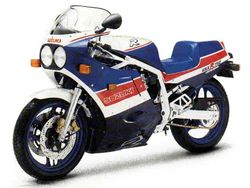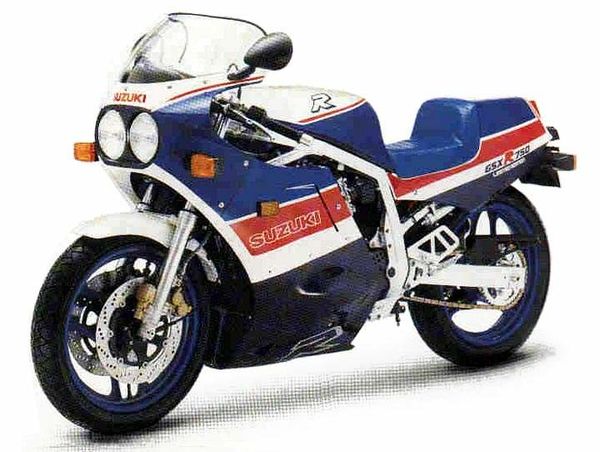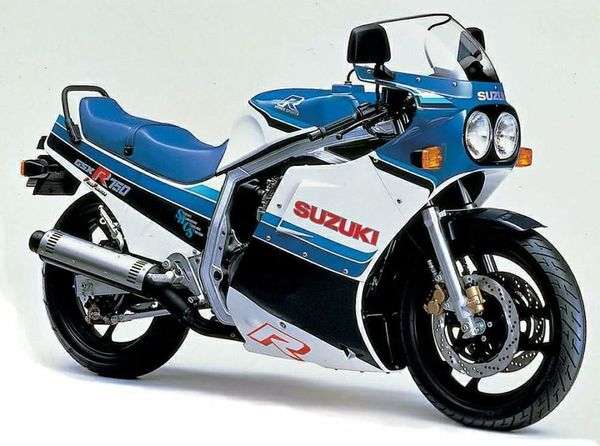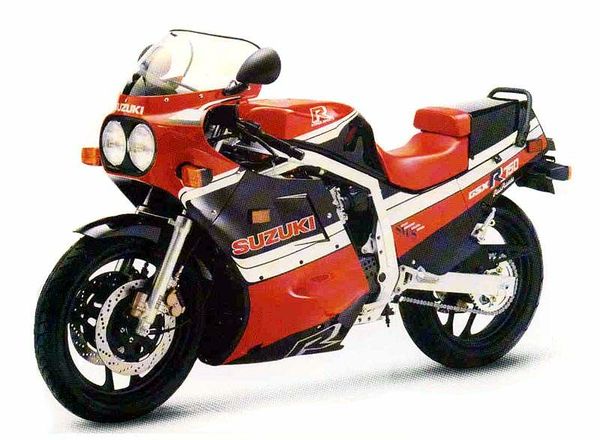Suzuki GSX-R 750H
 |
|
| Suzuki GSX-R 750H | |
| Manufacturer | |
|---|---|
| Production | 1987 |
| Class | Sportbike |
| Engine | Four stroke, transverse four cylinder, DOHC, 4 valves per cylinder |
| Compression ratio | 10.6:1 |
| Top Speed | 234.7 km/h / 145.8 mph |
| Ignition | Full transistor |
| Spark Plug | NGK DR8ES |
| Transmission | 6 Speed, constant mesh |
| Frame | Aluminum twin downtube |
| Suspension | Front: Posi Damp Fork (PDF), telescopic, pneumatic/coil spring, oil damped, 4-way adjustable damper, 41 mm Rear: Full Floater, oil damped, fully adjustable preload with remote hydraulic control, 4 damping position |
| Brakes | Front: 2 x 310 mm Discs, 4 piston calipers Rear: Single 280 mm disc, 1 piston caliper |
| Front Tire | 110/80 V18 |
| Rear Tire | 140/70 V18 |
| Wheelbase | 1445 mm / 57.3 in. |
| Seat Height | 755 mm / 29.7 in |
| Weight | 176 kg / 388 lbs (dry), 185 kg / 408 lbs (wet) |
| Recommended Oil | Suzuki ECSTAR 10w40 |
| Fuel Capacity | 21 Liters / 5.5 US gal / 4.6 Imp gal |
| Manuals | Service Manual |
It could reach a top speed of 234.7 km/h / 145.8 mph.
Engine[edit | edit source]
The engine was a Air/Oil cooled cooled Four stroke, transverse four cylinder, DOHC, 4 valves per cylinder. The engine featured a 10.6:1 compression ratio.
Drive[edit | edit source]
Power was moderated via the Cable operated, wet multiple, coil spring.
Chassis[edit | edit source]
It came with a 110/80 V18 front tire and a 140/70 V18 rear tire. Stopping was achieved via 2 x 310 mm Discs, 4 piston calipers in the front and a Single 280 mm disc, 1 piston caliper in the rear. The front suspension was a Posi Damp Fork (PDF), telescopic, pneumatic/coil spring, oil damped, 4-way adjustable damper, 41 mm while the rear was equipped with a Full Floater, oil damped, fully adjustable preload with remote hydraulic control, 4 damping position. The GSX-R 750H was fitted with a 21 Liters / 5.5 US gal / 4.6 Imp gal fuel tank. The bike weighed just 176 kg / 388 lbs. The wheelbase was 1445 mm / 57.3 in. long.
Photos[edit | edit source]
Overview[edit | edit source]
Suzuki GSX-R 750H
The production model gained the previous years limited GSX-R750R's exclusive features; stronger 41 mm diameter lightweight front forks with improved PDF (positive damping front fork) adjustability and the brake lever actuated electronic NEAS, stabilized with a steering damper. Biggest failing of these early F/G/H models was the steel-bodied rear shock which quickly overheated and faded. Larger (21 liter) fuel tank.
The original GSX-R750 was the bike with which modern Japanese super-sports motorcycles were invented. True, there had been plenty of last and fiery superbikes before the oil-cooled four was unleashed in 1985. But the GSX-R750 was the first modern race replica: a uniquely single-minded machine built for performance above all else.
Its layout matched that of Suzuki's endurance racers of the previous year, from the shape of the twin-headlamp fairing to the use of 18-inch wheels (favoured by endurance race teams because the larger diameter facilitated brake pad changes) instead of the then fashionable 16-inchers. Its frame was made from aluminum, instead of the steel used by rival superbikes. And its 749cc. DOHC 16-valve engine was powerful, with a peak output of 100bhp @ 10500rpm.
Oil cooling system
That output came from a motor that used the novel (for bikes) system of oil-cooling to reduce cylinder temperatures without the added bulk and weight of a water jacket. The Suzuki Advanced Cooling System. SACS for short, allowed the engineers to redesign the previous air-cooled GSX750 unit on a smaller, higher-revving scale. Almost every component lost weight by being smaller or. in the case of the cam cover, made from exotic magnesium instead of aluminum.
The GSX-R motor's output and lightness were
impressive, but it was the chassis that did most to give this bike its unmatched
power-to-weight ratio. At 3881b (176kg) the GSX-R was far lighter than any rival
750. According to Suzuki, the new aluminum frame, constructed from a
combination of cast sections and extruded tubes, weighed just I8lb (8kg). half
as much as the GSX750"s less rigid steel item. Front forks were stout 41 mm
units, their rigidity boosted by an aluminum brace.
A racy instrument console, with dials mounted in foam, hinted at the motor's liking for revs. Despite its row of Mikuni flat-slide carburettors the Suzuki was quite rideable even at low engine speed, feeling slightly buzzy without ever producing serious vibration. But its delivery was flat until 7000rpm. when the bike suddenly came alive, howling forward as the revs headed towards the 11000rpm limit.
High-revving performance
That high-revving performance, allied to a slick six-speed gearbox and a top speed of 145mph (233km/h), made the GSX-R a straight-line match for all its 750cc rivals. And in the bends the Suzuki pressed home its advantage. Despite its 18-inch front wheel the bike could be flicked into a turn with little effort, and was stable once leant over. The GSX-R's lack of weight was a benefit in corners and under braking, where it allowed the front brake - a combination of 300mm discs and four-piston calipers - to deliver unprecedented stopping power and feel.
But the GSX-R was one of the first road bikes to require careful setting-up. and preferably a steering damper, to handle well. The original model's occasional high-speed wobble prompted Suzuki to introduce a slightly longer swingarm in 1986. Practicality had barely been a consideration for the Suzuki's designers, but the GSX-R750 did have a protective fairing and a strong pillion grab-rail, to offset against its aggressive riding position, poor fuel range and narrow mirrors.
Source of review: Fast Bikes by Roland Brown
The GSX-R750 was built to compete in the various worldwide championships as well
as to be used on the street. It is considered as one the very first street-legal
racers, there had been a number of sports machines but the GSX-R750 was
something else. It was a revolutionary motorcycle with specifications like over
100 hp power output, less than 180 kg dry mass, 55° leaning angle, lightweight
alloy double-cradle perimeter frame, 18-inch wheels and streamlined design based
on the factory Formula 1 and Endurance racers.
The air/oil-cooled motor had cylinder dimensions of 70,0 x 48,7 mm and had 29 mm flat slide carbs. In a racing trim (there was a tuning kit available for competitive racing) the GSX-R750 engine provided 130 bhp. The new high-tech engine was narrower than earlier inline-fours and materials like magnesium was used to keep the weight down to minimum.
The GSX-R750 was basically a street-legal and detuned version of the works GS1000R racer. The flat slide carburetors gave faster response to the throttle compared to the vacuum carburetors. It also required the rider to be more gently with the throttle. There were no compromises, it was very quick in hands of a skillful rider but could be experienced as nervous and even dangerous.
That is certainly the case in old and abused machines. The components of the bike are all high quality but make sure that the tires, suspension and bearings are all in good condition or the bike can scare the living daylight out of you! The GSX-R750 engine is considered as reliable but we all know that there is no such thing as bulletproof engines. The frame of the early models is not that rigid and bend easily when dropped. The GSX-R750 entered the market in March 1985. There's not many bikes out there in mint condition, most of them are ridden very hard and seen their best days. Nevertheless the evolution of modern sports bikes started with the GSX-R750. It's a real classic.
1985 Suzuki year code: F
With the 1983 RG250 Gamma, Suzuki was the first factory to deliver a true racer
replica using race-bred technology to the public. The next step was to build a
4-stroke 400cc machine for the Japanese home market and a year later a 750cc
machine, culmination to the Suzuki's racing experiences in the World Endurance,
AMA Superbike and Championship. The GSX-R750 was first presented at the 1984
IFMA Cologne Show in West Germany. Although it was fully street legal, it was
clear that it was built even to compete in the various Worldwide Championships.
The GSX-R750F entered the market in March 1985. It was considered as the first production motorcycle to offer race-bred technology and performance at an affordable price. The design philosophy centered mainly on weight reduction. Suzuki went counter to the conventional design by developing SACS (Suzuki advanced cooling system) whereby the cylinder head and the pistons are oil cooled via the engine oil injection, achieving cooling efficiency as good as water-cooling without its weight increase. The computer designed engine package was 10% lighter than the water-cooled versions.
The GSX-R750 also featured the new TSCC (twin swirl combustion chamber) cylinder head, DAIS (direct air intake system , flat side carburetors, six-speed gearbox and hydraulic clutch engaged the power. The chassis featured the finest multi-rib extrusion molded aluminum box section piping and cold-cast aluminum alloy components, MR-ALBOX frame, that weighted 8,1 kg less than half of the conventional steel frames. These and other weight reduction measures gave the bike sensationally low dry weight of 179 kg, 20% lower than the competing 750s, resulting a superior power-to-weight ratio for much easier power control and quicker handling. Completing the GSX-R750 design was the endurance racer theme: dual headlights on the aerodynamics full fairing and 18-inch tires both front and rear.
| Make Model | Suzuki GSX-R 750H |
|---|---|
| Year | 1987 |
| Engine Type | Four stroke, transverse four cylinder, DOHC, 4 valves per cylinder |
| Displacement | 749 c / 45.7 cub. in |
| Bore X Stroke | 70.0 x 48.7 mm |
| Compression | 10.6:1 |
| Cooling System | Air/Oil cooled |
| Engine Oil | 10W/40 |
| Exhaust System | 4-into-1 Stainless-steel exhaust |
| Lubrication | Wet sump |
| Induction | 4 x VM2955 flat-valve carburetors |
| Ignition | Full transistor |
| Spark Plug | NGK DR8ES |
| Starting | Electric |
| Max Power | 72.9 kW / 100 hp @ 10500 rpm |
| Max Power Rear Tire | 68.6 kW / 92 hp @ 10500 rpm |
| Max Torque | 70.6 Nm / 7.2 kgf-m / 52.1 ft-lb @ 8000 rpm |
| Clutch | Cable operated, wet multiple, coil spring |
| Transmission | 6 Speed, constant mesh |
| Final Drive | #530 Chain, O-ring sealed |
| Gear Ratios | 1st 2.77 / 2nd 2.06 / 3rd 1.65 / 4th 1.40 / 5th 1.23 / 6th 1.09:1 |
| Frame | Aluminum twin downtube |
| Front Suspension | Posi Damp Fork (PDF), telescopic, pneumatic/coil spring, oil damped, 4-way adjustable damper, 41 mm |
| Rear Suspension | Full Floater, oil damped, fully adjustable preload with remote hydraulic control, 4 damping position |
| Front Brakes | 2 x 310 mm Discs, 4 piston calipers |
| Rear Brakes | Single 280 mm disc, 1 piston caliper |
| Wheels | Alloy, 6 spoke |
| Front Tire | 110/80 V18 |
| Rear Tire | 140/70 V18 |
| Wheelbase | 1445 mm / 57.3 in. |
| Dimensions | Length 2115mm / 83.3 in Width 745 mm / 29.3 in Height 1215 mm / 47.8 in |
| Seat Height | 755 mm / 29.7 in |
| Ground Clearance | 140 mm / 5.5 in |
| Dry Weight | 176 kg / 388 lbs |
| Wet Weight | 185 kg / 408 lbs |
| Fuel Capacity | 21 Liters / 5.5 US gal / 4.6 Imp gal |
| Average Consumption | 5.4 l/100 km / 14.8 km/l / 43.3 US mpg / 52.3 Imp mpg |
| Standing ¼ Mile | 11.2 sec / 195.2 km/h / 121.3 mph |
| Top Speed | 234.7 km/h / 145.8 mph |
| Road Test | Motosprint Group Test |


